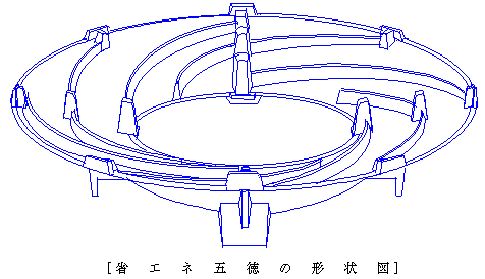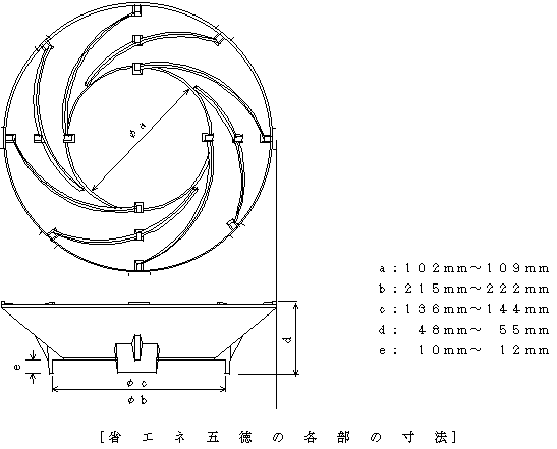Accident Information Special News19 Energy Saving Trivet""
March 6, 1998
Calling Attention Related to Carbon Monoxide Intoxication by so-called "Energy Saving Trivet"
Receiving the results of the test performed for settling accident information by the National Institute of Technology and Evaluation, in March 6, 1998, to prevent the similar accident from reoccurring, the Ministry of International Trade and Industry released the following information related to the attention calling on the carbon monoxide intoxication by so-called "Energy Saving Trivet".
1. Outline
In December 16, 1997, in Naha City, Okinawa Prefecture, a death accident by the carbon monoxide (hereinafter referred to as "CO") intoxication occurred during cooking with a so-called "Energy Saving Trivet" installed on a gas range. Later on, in February 3, 1998, the information that the origin of the death accident by the CO intoxication occurred in June 16, 1997, in Sapporo City, Hokkaido possibly is the "Energy Saving Trivet" was sent to the competent Ministry.
The so-called "Energy Saving Trivet" is a conical casting trivet, which is installed on a gas rage as a substitute after removing a trivet originally attached to the gas rage, has descriptions such as "Saving the gas rate by 30%" and "Economical and energy saving type" attached on the body, and is sold at something around 1,000Yen per each. (Refer to Separate Figure.) The sales agencies of the products are supposed to be Mon Pal Co., Ltd. and Sun Moon Co., Ltd. respectively and by having obtained the products sold by the both companies, the National Institute of Technology and Evaluation in the Ministry of International Trade and Industry performed the test for settling accident information. The result showed that, when a person cooks foods using the "Energy Saving Trivet", the air for the combustion becomes insufficient so as to cause incomplete combustion and a great volume of CO gas extremely exceeding the standard value (CO % (volume %) in theoretically dry combustion gas: 0.14% or less) is generated.
At the same time, the thermal efficiency test for the energy saving effects was performed to find that there is no significant difference between their efficiencies of the "Energy Saving Trivet" and the trivet originally attached to the gas range. Taking account of the present using environment of the gas rage such as high airtightness of the housing and the high calorie inclination of the gas range, when the "Energy Saving Trivet" is used, CO concentration increases and there is a possibility to cause the CO intoxication and, in the worst case, the death accident.
As long as the information grasped by the competent Ministry at present, companies other than Mon Pal Co., Ltd. and Sun Moon Co., Ltd. sell similar products with the similar shape and dimension. The number of the products reaches approximately 900,000 or more in the whole country and there is high possibility that the general consumer uses it at this moment.
To prevent the similar accident from reoccurring, the competent Ministry intends to call attentions of the persons using the so-called "Energy Saving Trivet" and immediately stop using it.
| Name of Product | Trivet for a gas range. | |
|---|---|---|
| Trade Name and Model | Energy Saving Trivet | Energy Saving Trivet |
| Sales Agencies | Mon Pal Co., Ltd. 3-7-17 Komatsu Higashi-Yodogawa-ku,Osaka-shi TEL06-324-8775 |
Sun Moon Co., Ltd. 3-20-59 Komatsu Higashi-Yodogawa-ku,Osaka-shi TEL06-328-6331 |
| Period of Selling | From 1990 to the end of 1997 | From June 1982 to January 1998 |
| Sold Number | 159,500 | approximately 750,000 |
| Number of CO intoxication accidents | 1 case | 1 case |
| Trade Name and Model | Nice Trivet | Energy Saving Trivet |
| Sales Agencies | Bix Wallow Co., Ltd. 227-4 Sakura-machi Tsubame-shi Niigata-ken TEL0256-63-9708 |
Aoki Industry Co., Ltd. (supposed to have gone bankrupt) 2423-5 Kagamishima Gifu-shi Gifu-ken stoppage |
| Period of Selling | From1992 to 1994 Unidentified | Unidentified |
| Sold Number | 18,400 | Unidentified |
| Number of CO intoxication accidents | None | None |
- (Note)These are the products grasped by the Ministry of International Trade and Industry so that it is possible that companies other than these sold the similar products.
(Problems of Appropriate Products)
The results of the test confirmed that, irrelevant to the type of gas, type of pots, and difference in thermal powers (wherein, excluding a low flame), only in a case of using the "Energy Saving Trivet" out of trivets sold at present, a great volume of CO gas extremely exceeding 0.14% (volume %) was generated from the flue gas. [The CO concentration in the theoretical dry combustion
gas is set to 0.14% (volume %) or less in the gas range sold on the market, on the assumption that the attached trivet is used.]
A reproduction test was performed using a mock room (six-mat room) under the ventilation rate 0.5 (state of changing the air in the room every 2 hours) to find that the CO concentration of the room became approximately 1,400 - 1,600 ppm approximately 2 hours later. [CO concentration 1,500 ppm: The intake of this concentration for 30minutes - 1 hour may threaten the
life.]
There was no significant difference between the thermal efficiencies when using the "Energy Saving Trivet" and the trivet attached to the gas range.
The products are characterized in having no energy saving effects as described in the advertisement, causing the incomplete combustion due to the structure of preventing the feeding of air for the combustion, and generated high concentration of CO.
2. Outlines of Accidents by Use of "Energy Saving Trivet"
- 1. In June 16, 1997, in Sapporo City, Hokkaido, a man cooking food in a large pot was died of CO intoxication.
As for the state of the ventilation, a small window in the side of a kitchen was slightly opened, however, no ventilator was used.
(Information Provider: Sapporo City Firehouse Information Provision Date: February 3, 1998) - 2. In December 16, 1997, in a reinforced-concrete apartment building in Naha City, Okinawa Prefecture, two persons (elder sister and younger brother) living together were found dead lying on a kitchen floor.
As for the state of the ventilation, though there was a natural ventilation type exhaust duct, no ventilator was attached thereto.
(Information Provider: Okinawa Prefecture Information Provision Date: December 22, 1997)
3. Matters Required Attention
Considering the accident information collected to the competent Ministry so far and the results of the test performed for settling accident information, when the so-called "Energy Saving Trivet" is used, the indoor CO concentration is increased to possibly bring about the risk of the life, because a great volume of CO gas is generated from the flue gas, the airtightness of the housing is enhanced, and the tendency of high calorie of the gas range is accelerated. From the viewpoint of the prevention of the similar accident from reoccurring, the users of the so-called "Energy Saving Trivet" are required to immediately stop using it.
4. Attentions
- (1)There seems to be no significant difference in the energy saving effects compared between a case using the "Energy Saving Trivet" and a case using a trivet attached to the gas range.
- (2)When handling a gas combustion apparatus, it is required attention to sufficiently ventilate and avoid using an auxiliary device on the market, which may cause incomplete combustion.
Separate figure


Contact us
- Consumer Product Safety Public Relations Division Product Safety Technology Center National Institute of Technology and Evaluation
-
Phone number:+81-6-6612-2066
Fax number:+81-6-6612-1617
Address:1-22-16 Nankokita, Suminoe-ku, Osaka-shi, Osaka 5590034, Japan MAP